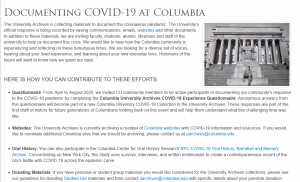As we come to the end of what has been a topsy-turvy year, we wanted to take a moment to look back on how the University Archives (UA) responded to the various challenges that came our way and what we’ve managed to accomplish since the library closed and New York went on pause in March.
Even in January and February, it was becoming clear that COVID-19 was going to have a wide impact, so much so that the UA started saving email communications from administration regarding travel restrictions due to the disease. To help administrators figure out a way forward, we provided some history. We spent the days prior to shutdown diving into our files and looking back to 1918 and the Spanish Influenza pandemic to see how Columbia responded (sanitary measures, but no shutdown). In the process we discovered how Columbia was affected by various polio outbreaks in the 20th century and learned that Columbia classes and commencement were affected by a cholera outbreak in the 1830s.
Events moved quickly in early March and after a frantic week of figuring out work-from-home projects and how to access work computers

remotely, we were officially asked to work from home as of March 16. One of our major projects evolved shortly after we started to work remotely. The UA was already documenting the University’s official response by saving communications, emails, websites and other documents. What was missing though was a more personal point of view, something we wished we had from 1918. So we made a decision to create an anonymous questionnaire which we distributed to the broader Columbia community in an effort to gauge people’s experiences, especially in the early months of the pandemic. From this diverse set of voices we are excited to now have first-hand accounts for future historians interested in knowing about our lived experience and our new everyday lives. Lastly, as part of our outreach efforts for the questionnaire, we have also received selected documentation from students, staff and faculty reflecting on their experiences for our collection.
In addition to documenting our current situation, the UA staff made numerous efforts to connect our community to campus and Columbia’s history via regular blog and social media posts. There was a wonderful series about Low Library (#WeMissLow), a postcard series on Facebook in the summer, a tribute to Alma Mater around her birthday in October, and historical posts about events made relevant by our current predicament (e.g, studying while living at home, transportation alternatives, changing the academic calendar). We even presented on CUL history as part of the “Staff Learning Online series” for library staff in June. Finally, our major exhibit about the Core Curriculum for its centennial (Insistent Change), which was briefly on display in RBML’s Kempner Gallery in February and early March, will now live on as a digital exhibition. Metadata for the exhibition materials was created while working remotely and the physical assets were able to be digitized in the fall when staff came back onsite on a limited basis. We anticipate that the digital version of this exhibit will be published and shared more broadly with students, staff and alumni early in 2021.
While working remotely, we were able to enhance (remote) access to our collections: creating new research guides, converting legacy finding aids both in our collections and UA-related collections in the RBML, adding metadata to the newly digitized audiovisual content, creating new records management training slides, and publishing a long-anticipated online finding aid to the various school bulletins. While fully remote it was pleasantly surprising how many questions we were able to answer with these online and digitized resources as well as the occasional assist from colleagues snapping photos of specific requested documents while inspecting our stack spaces each week.

Once back in the RBML on a limited basis in the fall, we were able to actively move forward with our audiovisual digitization work, prepping three large collections (Historical Records, Protest & Activism, and Varsity Show) for digitization – and to complete remediation of certain finding aids which started remotely but needed to be looked at physically to confirm contents. Having full access to collections has significantly improved our ability to provide remote reference services and scans to our patrons who are themselves mostly working remotely. There have been hundreds of requests answered and scans created in just a few months. Among the more significant research we conducted was tracking down information regarding the naming of Bard Hall when it was built (and is now about to be renamed), information on the earliest African-American Engineering graduate, James R. Priest, for whom a new scholarship was named this year, and numerous questions for the public affairs staff. We have also been able to accept several new donations of materials since returning to campus. One of the more interesting additions is a collection of memorial notes and signs that spontaneously sprung up at the feet of Alma Mater after Justice Ruth Bader Ginsburg’s passing in September.
It is rather remarkable how much was accomplished in such strange circumstances. We won’t soon forget 2020 and hope to continue our good work in 2021.